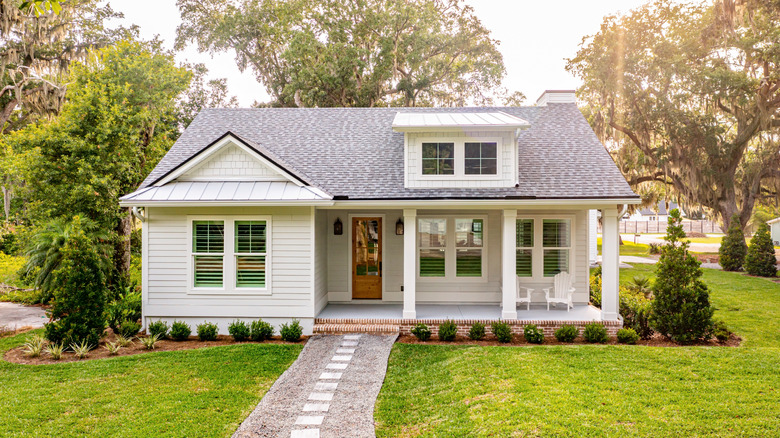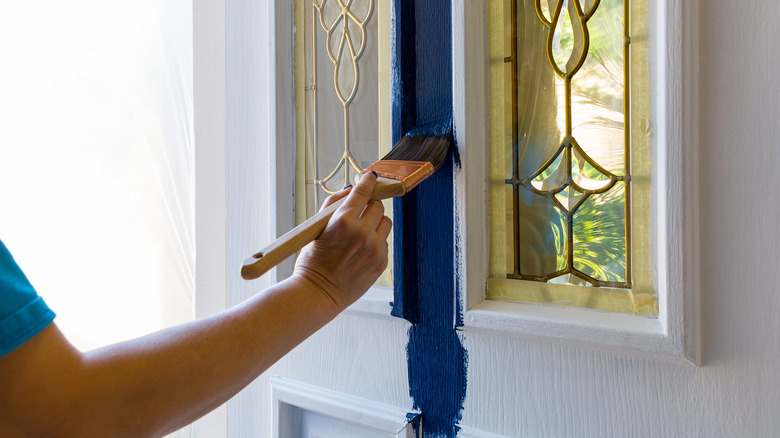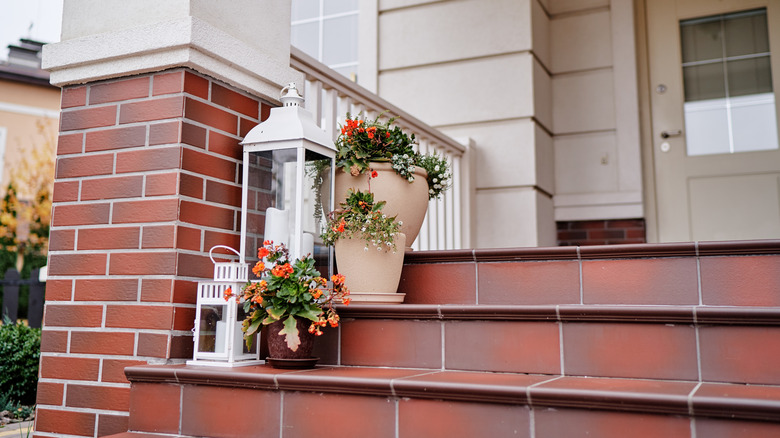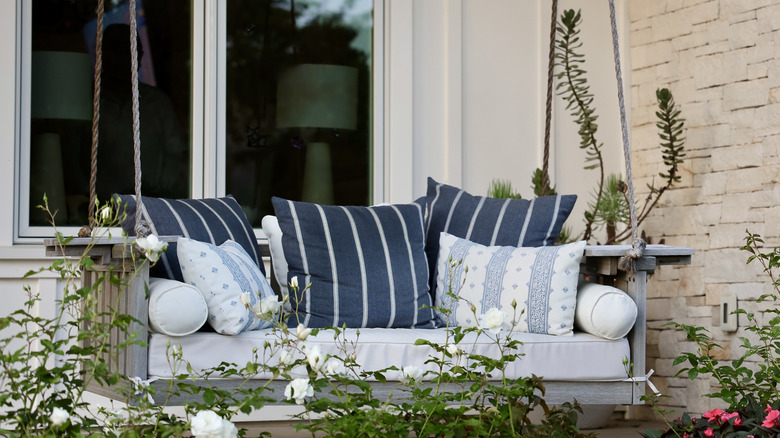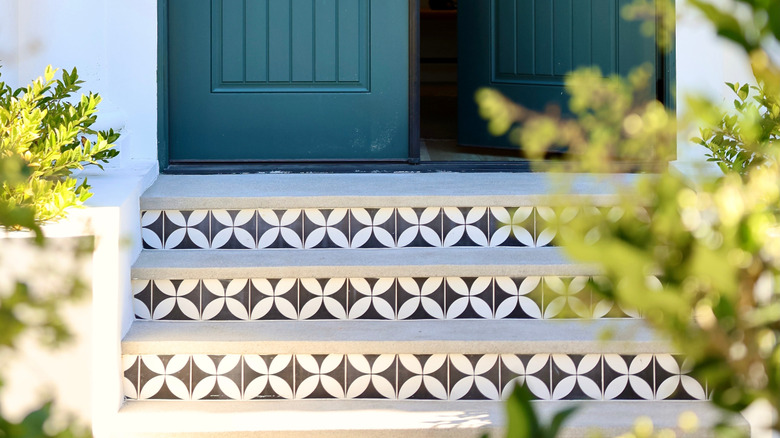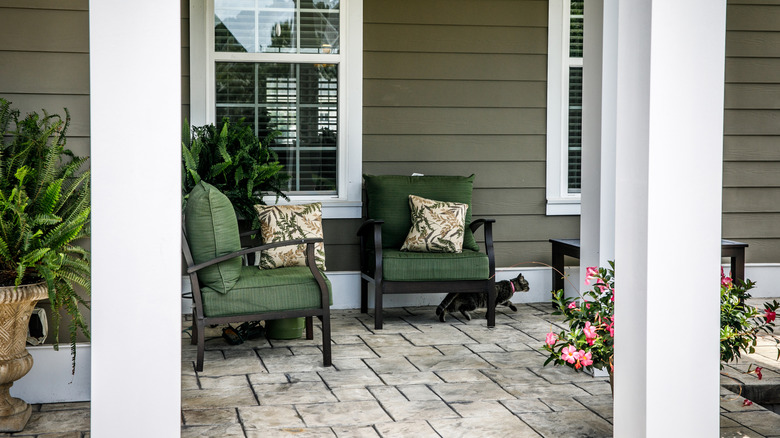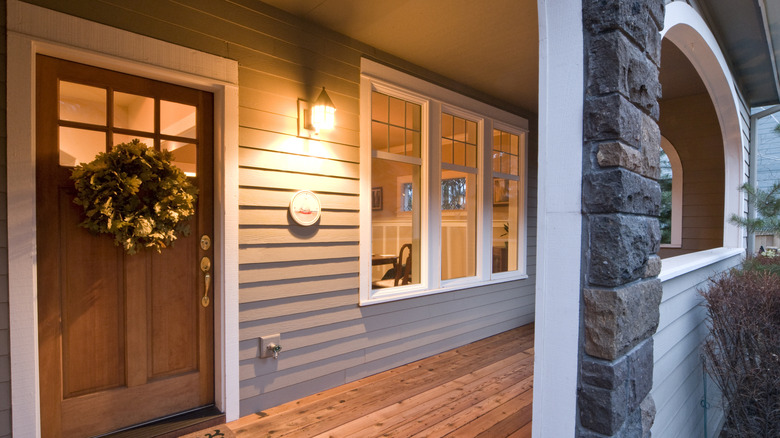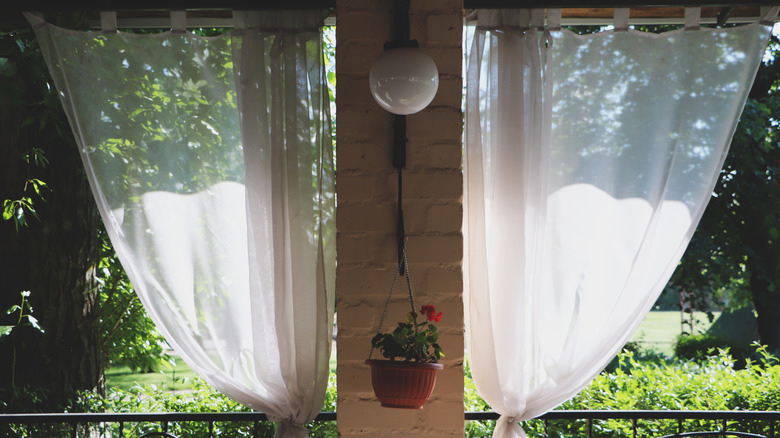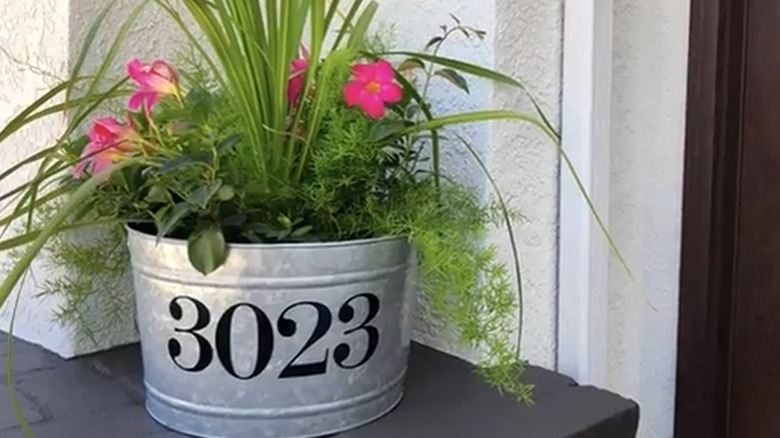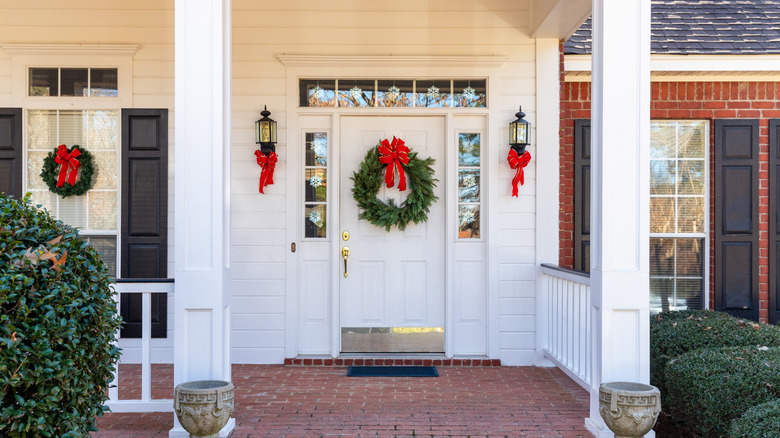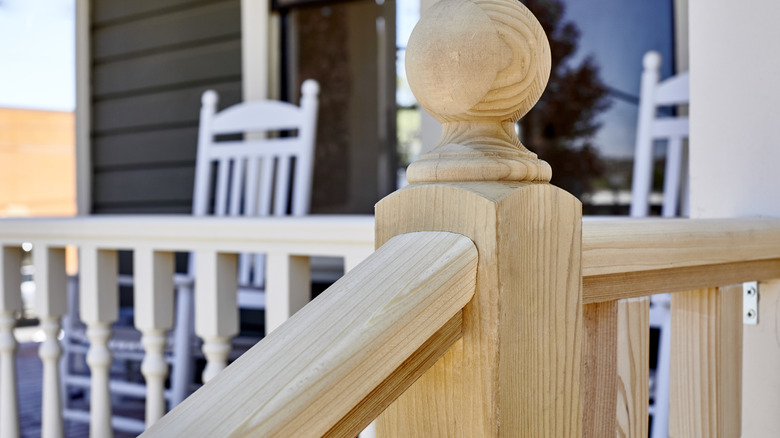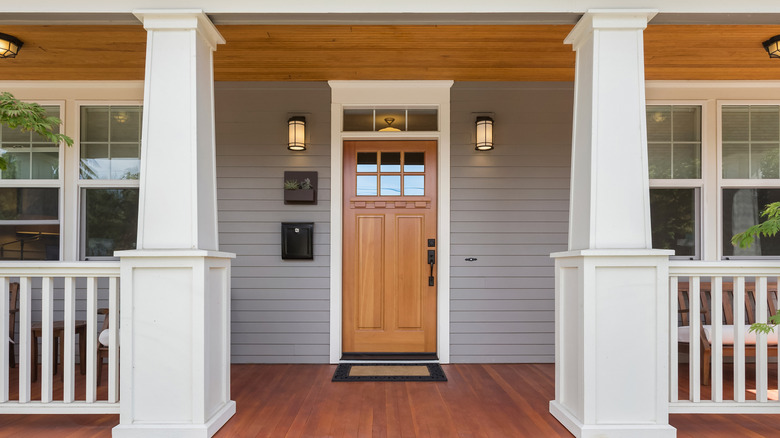14 Budget-Friendly Porch Upgrades You Can Complete In A Weekend
Your front porch is like the cover of a book — it's what people notice first. Sure, you shouldn't judge a book by its cover (or a house by its front porch), but it's natural to form first impressions there. Having a front porch in and of itself adds to your home's curb appeal — it adds dimension to the facade of your house. But there's room for customization and design to set your house apart. If your porch is lacking, you don't need a huge budget or a large amount of time to make a better impression.
We've put together 14 simple and affordable ways to breathe new life into your front porch. Even better, you can complete them in a weekend. Some tasks, like hanging curtains or installing new door hardware, take just a few hours. Others, such as painting the floor or front door, tiling your stair risers, or refreshing planters, often take more time throughout the weekend. Exploring these projects helps you create your list of must-haves to update your front porch.
Paint your front door a fresh color
Painting your worn front door gives you the chance to play with color for a fresh, personalized look. If the current color is outdated, new paint can make it look more modern and protect it from weather elements to make it last longer. It also gives you a chance to redo a door paint color that doesn't go well with your exterior color scheme. To paint the front door, you should only need a quart of paint, which costs between $10 and $30. Stocking up on paint supplies if you don't already have them could cost you up to $100. You can finish the job in a day — it'll take a few hours spread throughout the day while you wait for the paint to dry.
Before choosing a color, check with your HOA to see if there are restrictions. Consider the home's style, other exterior colors, and whether you want the door to stand out or blend in when choosing a color. It's important to be aware of the common mistakes to avoid when painting your front door for the best results. Cleaning, sanding, and priming the door well help you avoid many mistakes and provide smoother results.
Refresh old planters or upcycle them for porch plants
Potted plants bring color and life to your front porch, but those weather-worn planters that you've been using for years detract from the overall look. Older perennials that haven't been well-maintained can also look worn and hurt your home's curb appeal. A weekend is plenty of time to refresh your planters (or create new ones with upcycled items) and plant fresh flowers or greenery. The time commitment here is usually just a few hours, but you may need to add drying time between paint coats. Pricing also varies — if you're repurposing items you already own, its just a matter of buying any materials you don't have to refresh the look.
Start by emptying your old planters and giving them a good scrub to remove dirt and grime. If you like the shape and style of the planter, a fresh coat of paint and sealer could be the only thing the container needs. Upcycled planter options vary widely and include boots, strainers, sandboxes, kids' toys, dresser drawers, gutters, and toolboxes, just to name a few. Find an old item at home or hit the thrift store for a unique planter that showcases your personality — just make sure the items have good drainage. Once the planters are refreshed and full, use one on either side of the front door, or arrange three different pots in a group in a key spot on the porch.
Build or update a porch swing for relaxation
There's a reason many classic front porches features swings — they're a quintessential element to any relaxing front porch. There are many stylish swing ideas to cozy up your front porch, including buying a new swing, updating an old swing, or upcycling one from an old bed, bench, or other materials. If you build a porch swing from scratch, you can build a pine model for around $200. It'll be even better for the budget if you find a secondhand porch swing you can refinish or if you upcycle a piece of furniture you already own. Plan to spend both Saturday and Sunday building and hanging your swing — it's typically a two-day project if you're building the swing.
Before jumping into this project, make sure your porch will work — you need strong ceiling joists that can handle the weight of the swing and people. Measure to make sure you can leave 3 to 4 feet behind and in front of the swing for safe use. Having 24 inches on each end allows for easier use of your porch with adequate walkways around the swing.
Tile the front step risers
Your front steps need to be safe and sturdy, but that doesn't mean they have to be boring. Tiling the stair risers, which are the vertical portions of the steps, lets you add patterning, texture, and personality to this focal point leading to your front porch. Because the risers are vertical, the tiles are easy to see as people approach your house, making a big visual impact. Since you're only tiling the stair risers, the process shouldn't take more than a few hours. You'll have to wait 24 to 48 hours before you can grout the tiles, though, so plan this project for a long weekend. Pricing varies based on the tiles you choose and the size of your staircase — outdoor porcelain tiles can range from $1 to $35 per square foot.
Ensure the tiles, adhesive, and grout you choose are for outdoor use. Solid-colored tiles offer a simple, clean look while patterned or multicolored tiles create an interesting look. Darker tiles with patterns tend to hide dirt better, which is ideal outdoors. If you choose patterned tiles, make sure they fit with the overall facade of your home and won't make it look too busy or distracting.
Stain or paint worn wood to refresh your porch
You might not think the floor and ceiling of your porch make a big impact, but they're such large features that they draw attention. Painting your porch ceiling is the perfect way to upgrade your outdoor space, along with redoing the floor. Painting or staining your porch yourself is a cost effective option — it could cost you between $20 and $250 for the stain, but you may also need to buy or rent sanders and pressure washers to complete the job. Stain can take anywhere from two to 12 hours to dry, which is how long you'll have to wait to complete the second coat. The amount of time it takes to paint or stain the floor or ceiling depends on the size.
Choose a dry weekend for this project — you don't want rain for at least 12 to 24 hours after applying the new finish. It's important to start with a clean surface to get a smooth finish that sticks well. If you're painting the ceiling and floor, start with the ceiling to prevent drips on your newly finished floor. Drop cloths also help protect the floorboards.
Add a permanent rug to your porch with paint
If your porch doesn't need to be painted or stained, you can still make the floor more interesting. Painting patterns or a faux rug directly onto the porch floor creates a fun focal point. This project is relatively inexpensive as the main items you need are floor paint, painter's tape, and rollers. One quart of paint covers about 100 square feet, so the size of your rug will determine whether you need a quart or a gallon — if you're using multiple colors, a quart of each color should be enough.
To paint your permanent rug, choose your location and decide on the size. Use a yard stick or level to ensure the lines are straight, and use painter's tape to create the outline. From there, you can use tape to make borders, stripes, geometric shapes, and other designs. Another option is to use stencils to customize the rug pattern. Simply roll on the paint in the different sections based on your selected colors and designs. Various painting techniques can change the appearance of the paint. To make it look more like fibers, add a little paint extender to your last coat, and lightly rub steel wool over the paint.
Arrange a cozy conversation nook with curated seating
Designing a cozy seating area is one of many ideas that turn your front porch into an outdoor oasis. While backyards are often areas where you gather, adding a seating area to your front porch creates a welcoming vibe, especially if you want to connect with neighbors or make guests feel immediately welcome. You don't need to buy brand new patio furniture — that can be expensive. Renovating what you have, borrowing indoor furniture you no longer use, or making over secondhand patio furniture keeps the costs low. The time and cost of this porch makeover vary significantly depending on what you use and how much work you do on the furniture. If you're mainly repurposing items you already have, you can have a cozy conversation nook in an hour or two.
Start by curating the furniture. If your current pieces work (or you thrift pieces in good condition), give them a good cleaning with soapy water, rinse them well, and let them dry. Dealing with rusty metal furniture? Use a wire brush or sandpaper to remove the rust followed by a rust-removing solvent. Then prime and paint the furniture. Swap out old cushions for a softer feel. Add throw pillows, or cover old throw pillows with replacement covers, like these Pyonic Outdoor Waterproof Throw Pillow Covers. Positioning the chairs to face one another encourages conversation. Add a throw rug, end table, and decor pieces to make it feel like a living room.
Brighten the porch with additional lighting
If your front porch has a single light next to the door, you're missing out on the warmth of adequate lighting. It also limits how you can use the porch after dark. There are lots of budget-friendly lighting ideas that work no matter what your style is to illuminate your front porch and draw attention to it at night. Adding new forms of lighting takes a few hours at the most, unless you're having new lights added and need to hire an electrician. While the average cost for a new outdoor wall light is $120, you can find a range of options, including some that are under $20.
Check out your porch at night to look for the dark areas. If your current wall fixture is broken or outdated, consider swapping it out for a refreshed look. Battery-powered outdoor wall lights allow you to add more fixtures without hardwiring them. Then, look for other ways to layer light throughout your porch. String lights overhead cast a warm glow throughout the porch area without having to hire an electrician. If you want a glow lower on the porch, attach waterproof rope lights along the railing where they're hidden from the road. Solar lights along the sidewalk leading up to your porch also draw attention.
Hang curtains to add privacy and a whimsical touch
Curtains can add privacy and style to your front porch, and they're a simple and inexpensive makeover. Hanging curtains from your porch roof creates a whimsical look while blocking the view of nosey neighbors and shielding you from harsh sunlight. You can typically hang curtains in about two hours. If you have a large porch and want to hang panels along all sides, the project will likely take you longer. Outdoor curtain prices vary with options starting under $20 per panel for fabric designed to stand up to UV rays and weather elements.
Choose outdoor curtains to prevent them from molding or deteriorating quickly. Sheer fabrics offer subtle privacy while still keeping your porch bright and airy. If you want more privacy or heavier sun filtration, choose thicker fabrics. Decide if you want to hang the curtains around the entire porch or just on the ends. Then, hang the curtains either by installing a curtain rod or stringing a wire rope through the curtain's grommets.
Make your house numbers stand out
Finding ways to creatively display house numbers spruces up your front porch and helps visitors and delivery drivers find your house. Before swapping out your house numbers, keep in mind that your local jurisdiction may have specific regulations about house numbers, including the location, size, and contrast with the background. It's common to require the numbers be visible from the street, and you may need to have them illuminated at night. Premade house numbers are often inexpensive and take only a few minutes to hang. If you're DIYing a larger display, the cost of supplies will vary, and you could spend several hours completing the task.
For an easy update, swap out your current numbers for a different font, material, or color. Sleek stainless steel numbers without any flourishes fit a modern vibe, while you might prefer wooden numbers that look aged to deliver a farmhouse look. To add something extra, attach the numbers to a wooden plaque, either left plain or painted in your preferred color and pattern. Another popular option is to build a wooden wall-mounted planter with a flat surface for the numbers. Paint your house numbers on a large planter in addition to the numbers on the side of your house for an extra touch. Or, paint the letters in a large font directly on your front door.
Install decorative hardware or upgrade the existing hardware
New hardware is a simple swap that'll give your front door a stylish upgrade without any paint. You can get a new decorative door handle set for $100 to $200, but you can find basic sets for under $100 if you simply want to replace scratched or damaged knobs. Extra hardware, like specialty hinges and door knockers, come at an additional cost. Changing exterior door hardware should only take one to two hours, so you'll still have plenty of time in your weekend for other upgrades (or extra relaxation time).
Replacing your existing door knob with an upgraded model refreshes the door. Choose a finish or style that better matches your home and stands out against your door. If you want to amp up the hardware, choose large, decorative hinges with intricate detailing and a wide design that adorns the exterior of the door. An embellished door knocker and a mail slot are other features that quickly dress up a front door.
Add shutters and window boxes for a nostalgic look
There's something nostalgic about window boxes. You can build a small window box in two to four hours using a few cedar boards, which cost around $10 each, to create a longer-lasting display. If you prefer premade window boxes, they range from under $20 to well over $100. Shutters typically cost between $50 and $150 per window, but you can refinish used shutters found at secondhand outlets.
Decide which windows you want to add the embellishments to and which features you're adding. If your home already has shutters you love, simply add window boxes. Or maybe you don't like the look of shutters and want to go with just the flower boxes. You don't need shutters on every window, but make sure the front of your home looks balanced if you skip some windows. When it comes to filling window boxes, you can plant real flowers or use artificial blooms that you change with the seasons.
Replace the stair railings for style and security
An outdated stair rail leading to your front porch creates an eyesore, and it could also be a safety hazard if it's not sturdy. Replacing the railing gives your visitors a sturdy place to support themselves, and it's a great way to add a little style to your front porch. Stair railing installation is more complex than some projects — the railing needs to meet building codes for safety — so it could take a day or more to complete. Exterior stair railing kits are available for about $100, but the project may cost more for a longer run of steps.
A simple wooden or metal railing offers the most cost-effective solution and creates a classic look. If you prefer a more modern look, you might combine wood and metal or install cables instead of vertical balusters. Topping the posts of your railing with solar-powered lights gives them a decorative finishing touch while highlighting your home's entrance.
Wrap porch columns for an updated look
Slim, plain, or outdated porch posts may serve their purpose, but they lack character. Wrapping those posts is an easy way to update them and create an architectural focal point on your front porch. Porch column wraps aren't meant to be structural — they're decorative pieces that surround the existing, load-bearing post to make it look better. Premade column wraps can be pricy — while some are available for under $100, other more ornate options are several hundred. Building simple covers with plywood is often a more affordable option. The project could take you several hours over one or two days depending on how many posts you wrap.
Vinyl and PVC are two durable material options for wraps, but wood is often an easier option if your DIYing the wraps. If you build your own wraps from wood, decide if you want plain, straight wood panels or if you want to add decorative trim and designs. The color of paint or stain you choose also helps your wraps stand out and become focal points.
